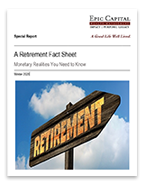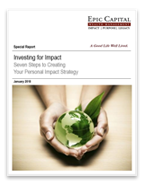Stress Test Your Portfolio
Mar 27, 2014
I believe it was Peter Lynch, the legendary mutual fund manager of the Fidelity Magellan Fund that once said, “Prior to retirement have as much in stocks as you can possibly stomach, and then after retirement, have as much in stocks as you can possibly stomach.” In other words, the amount of risk you should take in the stock market, completely and without question, depends on your own personal tolerance for risk. How much risk can you stomach? That’s the million dollar question.
Last month we discussed controlling the one thing that you can control when investing and that’s YOU. Hence, keep your emotions in check. Easier said than done, right? Or is it?
Most of us probably have some maximum level of tolerance for the emotional pain of losing money (albeit in most cases, we’re talking about temporary losses during a market downturn). Do you know what that level is for you? Let’s say you have an investment portfolio worth $500,000. At what level would you really begin to panic if it began to lose value? Would you be losing sleep if it was down $50,000? What about $100,000? I’m going to assume we have some pretty savvy investors reading this, so how about $200,000? Would that send you running for cover in Certificates of Deposit or cashing out to stuff the remainder in your bed mattress? What if you saw it drop by half? Two-hundred and fifty smackers. That’s big. That should cause just about anyone, even the most iron-stomached seasoned investment vet to get weak-kneed.
That 50 percent market plunge actually happened, only about five years ago. I’m sure most remember it like it was yesterday. I certainly do. Painful memories. But here’s the thing; just because the market was down 50 percent, doesn’t mean that your entire investment portfolio should be down the same. In fact, one would have to have had a portfolio of basically 100 percent stocks in order to have lost in lock-step with the market. If one did, then they should have realized that their entire investment portfolio could lose that much. It did in 1929, it almost did that in 1987 and it certainly did similar in 2000 after the dot-com bubble burst. Two-thousand and eight was an eye-opener of a year for susceptibility to loss, and it hopefully stands as a lesson that screams “Pay attention to the level of risk you are taking!”
Here’s a question for everyone: Do you know the approximate level of risk you are taking in your investment portfolio? In other words, do you know what you stand to lose (hopefully only temporarily) if the market did drop, let’s say 10% or 20%, or even 30%? If not, you should. I call it “Stress-Testing” your portfolio. And this type of test can be applied to more than just stock-market corrections, it can be applied to (what we are now seeing) rising interest rates and the negative effects they can have on your bond investments. Further, it can be applied to a calamity of events like 2008 when almost nothing was safe and most asset classes (ie. stocks, bonds, real estate, commodities, gold) lost money.
Here’s a very simplified example: If you had $1,000,000 investment portfolio, of which 50 percent of it was in the S&P 500 index, and the remainder was in cash (earning zero percent interest, but with zero risk), we could approximate that the “potential” loss on your portfolio to be about 25%, or $250,000. That calculation comes with historical data that suggests that the stock market, realistically, could pull back at least 50% as it has in the past. Although rare and infrequent, one can’t rule it out. So if 50 percent of the account dropped 50 percent in value, then the total portfolio would drop $250,000 or 25 percent (of the $1,000,000). If one can’t stomach losing 25 percent of their account value at any given time, or $250,000 on $1,000,000 of retirement savings, then they probably shouldn’t be 50 percent in stocks.
What if the other half wasn’t in cash, but it was in bonds? There is no certainty that a bond or bond fund won’t lose money, so therefore the risk is no longer 25 percent. A portfolio of half stocks and half bonds would logically have to increase the level of risk, or the potential level of drawdown, right? See, the idea is not to try to determine exactly what you stand to lose, it’s simply a process that is used to determine the approximate level of risk that you are susceptible to given you current investments or portfolio allocation mix.
The biggest problem in 2008 is that most investors didn’t know the level of risk that they were taking going into 2008. Therefore when seemingly everything went down, it caused emotional panic and many investors ended up selling out of their investments, or moving to a very conservative posture and taking large losses (selling low, the ultimate investor regret).
Here’s the thing: know the level of risk you are taking and you will most likely never need to hit the panic button or overly concern yourself with market drawdowns or portfolio losses. If you understand, and willingly accept, the level of risk that can be wrought on your investment accounts, it will make it that much more tolerable when it happens and most likely prevent you from taking any emotion-based actions, or second-guessing your strategy, which can derail your long-term planning.
Have your financial advisor Charlotte, NC stress-test your portfolio today.
As Seen in Society Charlotte Magazine, April 2014. Written by Edward R. Doughty, CFP®.
More Insights
Few terms in personal finance are as important, or used as frequently, as “risk.” Nevertheless, few terms are as imprecisely defined. Generally, when financial advisors or the media talk about investment risk, their focus is on the historical price volatility of the asset or investment under discussion.
As Americans get their grills and beach chairs ready for the July 4th holiday, the stock market and the weather across much of the country have both been on heaters. Stocks and bonds continue to effectively navigate a complex policy landscape shaped by evolving trade dynamics, geopolitical tensions, and fiscal stimulus. The market’s resilience in … Continue reading “Market Update – America Gets Record High Stock Prices for Its Birthday”
Birthdays may seem less important as you grow older. They may not offer the impact of watershed moments such as getting a driver’s license at 16 and voting at 18. But beginning at age 50, there are several key birthdays that can affect your tax situation, health-care eligibility, and retirement benefits.
During times like these when geopolitical headlines can be unsettling for investors, we at LPL Research like to remind ourselves of one of our key investing principles. Markets have always faced challenges —ranging from geopolitical conflicts and economic downturns to natural disasters, political upheaval and health crises. These events often trigger short-term volatility and shake … Continue reading “Why Long Term Investing Beats Selling in Volatile Times”
Are you concerned about the inheritance taxes your heirs may have to pay? Then you may want to consider creating charitable lead trusts.
Services
Epic Capital provides the following comprehensive financial planning and investment management services: Learn More >


 Top of Page
Top of Page











